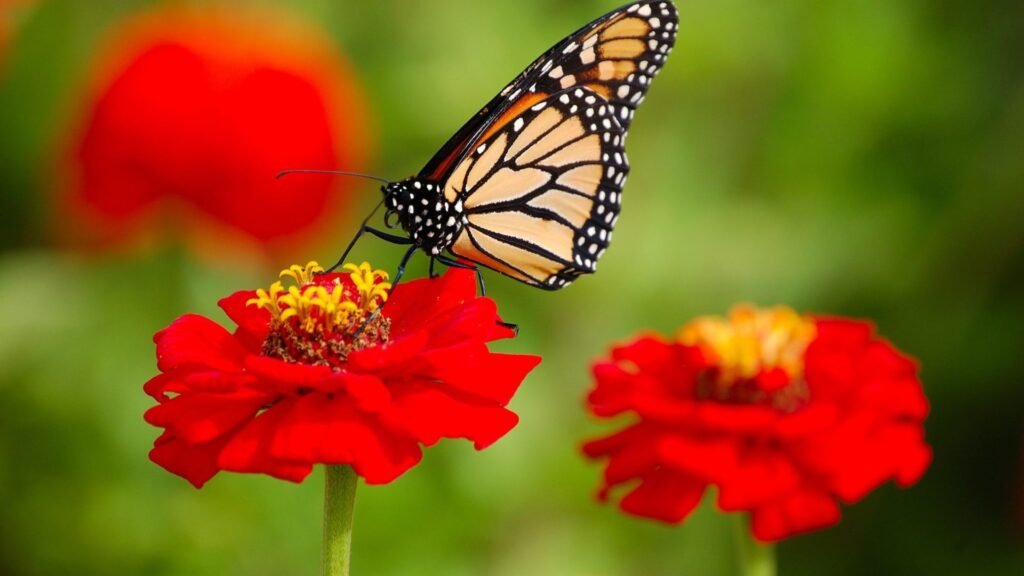Ways to Attract Butterflies to Your Garden with Flowers
Attracting butterflies to your garden not only adds a splash of color but also supports local ecosystems by promoting pollination. Using flowers is one of the most effective ways to draw these beautiful insects into your outdoor space. In this guide, we’ll explore the best ways to attract butterflies to your garden with flowers, ensuring a vibrant and lively garden.

Choose the Right Flowers
First and foremost, selecting the right flowers is crucial for attracting butterflies. Butterflies are drawn to bright, nectar-rich flowers. Some of their favorites include milkweed, coneflowers, asters, and marigolds. These flowers provide ample nectar and are easy for butterflies to access. By planting a variety of these blooms, you can create an inviting environment for butterflies.
Plant Native Species
Planting native flowers is another effective way to attract butterflies to your garden. Native plants are well-adapted to your local climate and soil conditions, making them more resilient and easier to maintain. Additionally, local butterflies are more likely to recognize and be attracted to native plants. Research native flowering plants in your area and incorporate them into your garden design.
Provide Continuous Bloom
Butterflies need nectar throughout the growing season, so it’s important to have flowers that bloom at different times. By choosing a variety of plants that flower from early spring to late fall, you can ensure a constant food source for butterflies. Some early bloomers include Columbine and Bleeding Heart, while late bloomers like Sedum and Goldenrod extend the season.
Create Clusters of Flowers
Butterflies are more likely to visit gardens with large, colorful flower clusters rather than scattered individual plants. Grouping flowers makes it easier for butterflies to spot them from a distance. Aim to plant clusters of the same flower species in groups of three or more. This not only attracts butterflies but also creates a visually appealing garden.
Offer Sunlight and Shelter
Butterflies are cold-blooded and rely on the sun to regulate their body temperature. They prefer sunny, sheltered spots where they can bask and warm up. When planning your garden, ensure there are sunny areas with minimal wind. You can create sheltered spots by planting taller shrubs or using garden structures like trellises and fences.
Provide Host Plants for Caterpillars
To attract butterflies, it’s essential to provide host plants for their caterpillars. Host plants are where butterflies lay their eggs, and where caterpillars feed and grow. Different butterfly species have specific host plants, so it’s important to include a variety. For example, monarch butterflies need milkweed, while black swallowtails prefer dill, fennel, and parsley. Including these plants ensures that butterflies will want to stay and reproduce in your garden.
Avoid Pesticides
Pesticides can be harmful to butterflies and other beneficial insects. To create a butterfly-friendly garden, avoid using chemical pesticides and opt for natural pest control methods. Encourage beneficial insects like ladybugs and lacewings that prey on garden pests. Additionally, handpicking pests and using organic treatments can help keep your garden healthy without harming butterflies.
Provide Water Sources
Butterflies need water, but they can’t drink from open water sources like birds. Instead, they prefer shallow puddles or damp soil. Create a butterfly-friendly water source by filling a shallow dish with sand and adding water until the sand is moist. Place the dish in a sunny spot in your garden, and refresh the water regularly. This provides a safe and accessible drinking spot for butterflies.
Add Flat Rocks for Basking
Butterflies enjoy basking in the sun to warm their bodies. Adding flat rocks or stone pathways to your garden gives butterflies a place to rest and soak up the sun. Place these rocks in sunny areas, and you’ll often see butterflies perched on them, especially during the cooler parts of the day.
Create a Butterfly Habitat
In addition to flowers, butterflies need places to rest and hide from predators. Creating a butterfly habitat involves providing a mix of sun, shade, and shelter. Planting a diverse range of plants, including shrubs and tall grasses, can create a layered environment that offers protection and nesting sites. This holistic approach ensures a welcoming environment for butterflies throughout their lifecycle.
Conclusion
In conclusion, attracting butterflies to your garden with flowers involves choosing the right plants, providing continuous blooms, and creating a suitable habitat. By planting native species, offering host plants for caterpillars, avoiding pesticides, and providing water sources, you can create a butterfly-friendly garden that supports these beautiful pollinators. Remember, a garden designed with butterflies in mind not only enhances its beauty but also promotes a healthy ecosystem. Enjoy the fluttering colors and the joy they bring to your outdoor space.



